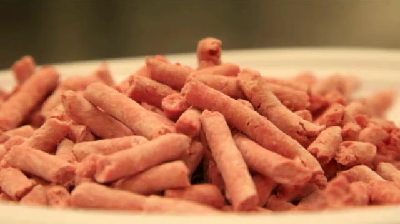- cross-posted to:
- todayilearned@lemmit.online
- cross-posted to:
- todayilearned@lemmit.online
cross-posted from: https://lemmit.online/post/6090142
TIL in December 2018, lean finely textured beef(pink slime) was reclassified as “ground beef” by the Food Safety And Inspection Service of the United States Department Of Agriculture. It is banned…
This is an automated archive made by the Lemmit Bot.
The original was posted on /r/todayilearned by /u/ALSX3 on 2025-06-16 14:13:49+00:00.
Original Title: TIL in December 2018, lean finely textured beef(pink slime) was reclassified as “ground beef” by the Food Safety And Inspection Service of the United States Department Of Agriculture. It is banned in Canada and the EU.
Cancer sticks, now without the need to smoke them
Jee why dont we want to expand trade with drug filled agricultural goods with shit standards?
I find it annoying they try to pose this as such an ugly product because of how it looks. It’s ground up meat, why does it being “pink slime” make people cringe so bad?
Adding the ammonia and the chemical treatment of food is a different topic that is disgusting. But the appearance factor is nonsense to me. Some people need to make their own food, a lot of it is pretty gross until complete.
Ground up animal bits. Calling it ground up meat is a slight exaggeration. There is some very hard to get at meat in there though.
Mechanically separated meat is an effective way to turn every shred of animal into an edible product instead of sending it off to be processed again into some lower value product. If you’re gonna spend all the time and resources to raise and kill an animal for food, why not make sure that the absolute maximum of it is turned into an edible product?
In general I agree. But the question is whether you can actually produce the product without the ammonia and chemicals.
chemicals
Dog whistle. Using the term ‘chemicals’ as a negative serves only to gain support from the ignorant by obscuring the topic. All meat is treated with chemicals before you eat it, a solution of solvent, explosive sodium metal, and deadly chlorine being the most common.
I don’t think salt is added to most meat before being sold to the customer. I think you are being disengenuous.
I worked at a meat processing plant, salt water is added to every piece of meat that went through there in order to bulk up the weight and increase margins. Sometimes it is just a soak in other cases (like peameal bacon) they inject it with 200 steel needles and a hydraulic pump.
Okay but I think you can read between the lines that salt wasn’t the chemical that anyone was talking about here.
I can but can you look at a list of “chemicals” and identify which ones are food safe ingredients and which are hazardous? Not many people can, and using the label “chemicals” makes the problem worse.
For example polyethylene glycol is a food additive in Dr Pepper but ethylene glycol the poisonous part of anti-freeze. If you do not specify what chemicals you are concerned about and why then you are just using a catchall term to paint a particular product or process as bad.
You make an excellent point! Companies should not be allowed to use complex chemical names on food labels and instead should be forced to use words that consumers can recognize and use to make better informed decisions about the products they’re consuming.
you true
If your Big Mac starts tasting a little, um, slimy? That’s just a whole mouth fulla FREEDOM.
Lean finely textured beef can constitute up to 15% of ground beef without additional labeling
Well done
Because of ammonium hydroxide use in its processing, the lean finely textured beef by BPI is not permitted in Canada.[8] Health Canada stated that: “Ammonia is not permitted in Canada to be used in ground beef or meats during their production” and may not be imported, as the Canadian Food and Drugs Act requires that imported meat products meet the same standards and requirements as domestic meat.[8][9] Canada does allow Cargill’s citric acid-produced Finely Textured Meat (FTM) to be “used in the preparation of ground meat” and “identified as ground meat” under certain conditions.
It’s specifically because of the ammonia, apparently? Idk I feel like I don’t want to learn more because only horrors await me.
Just don’t ever look up what candies are made of. Some of the most delicious tasting foods are made from some of the most vile things.
Don’t even get me started on imitation vanilla…
Imitation vinilla hasn’t been made that way for decades. You almost certainly never eaten anything with it in it.
Less than 250 lbs of the stuff was consumed in the US in 1987 and it’s only gone down from there.
It’s actually significantly more expensive than sythensized alternatives like vanillin since there is basically no commercial beaver trapping anymore.
Decades before this was something I could scare the girls in food class with, it was already not true.
Is it bugs? I bet it’s bugs.
The vast majority is synthesized. Often from a wood byproduct.
They were probably referring to the old “it’s made from beaver anuses” joke. Where in reality castoreum is extracted from an organ under skin near the tail. And is still used in very small amounts in some applications.
Every time we have this clarification, I imagine a scientist in a lab coat holding a beaver up by the tail, and pointing out the spot near the anus, which is not the anus.
But to anyone standing near by, they’re still just effectively pointing out the beaver’s anus.
I get that the myth is wrong, but the reality isn’t enough better to be comforting.
It used to be made from beaver “secretions” whatever that might mean, not anymore but still.
You’re talking about Castroreum. Basically beaver “musk”. Which honesty not that weird. If you want weird, be weary of any deep red food that claims natural coloring
Hey just curious who was the administration in charge at that time??
Orange slime
weird that it isn’t considered organic dispite not using fertilizer or pesticides
can’t tell if you’re serious or taking the piss, but for reference meat has to be fed with things that are themselves organic to be classed as organic.
to quote the Wikipedia article:
Most of the finely textured beef is produced and sold by BPI, Cargill and Tyson Foods.[29][30] As of March 2012 there was no labeling of the product, and only a USDA Organic label would have indicated that beef contained no “pink slime”.
to me implies that even if the meat would have otherwise been organic, that the processing makes it no longer be.
‘Organic’ is poorly-defined wishy-washy bullshit, so don’t expect logic or reason
US organic is bullshit. Canada has strict guidelines on what can be labeled organic











